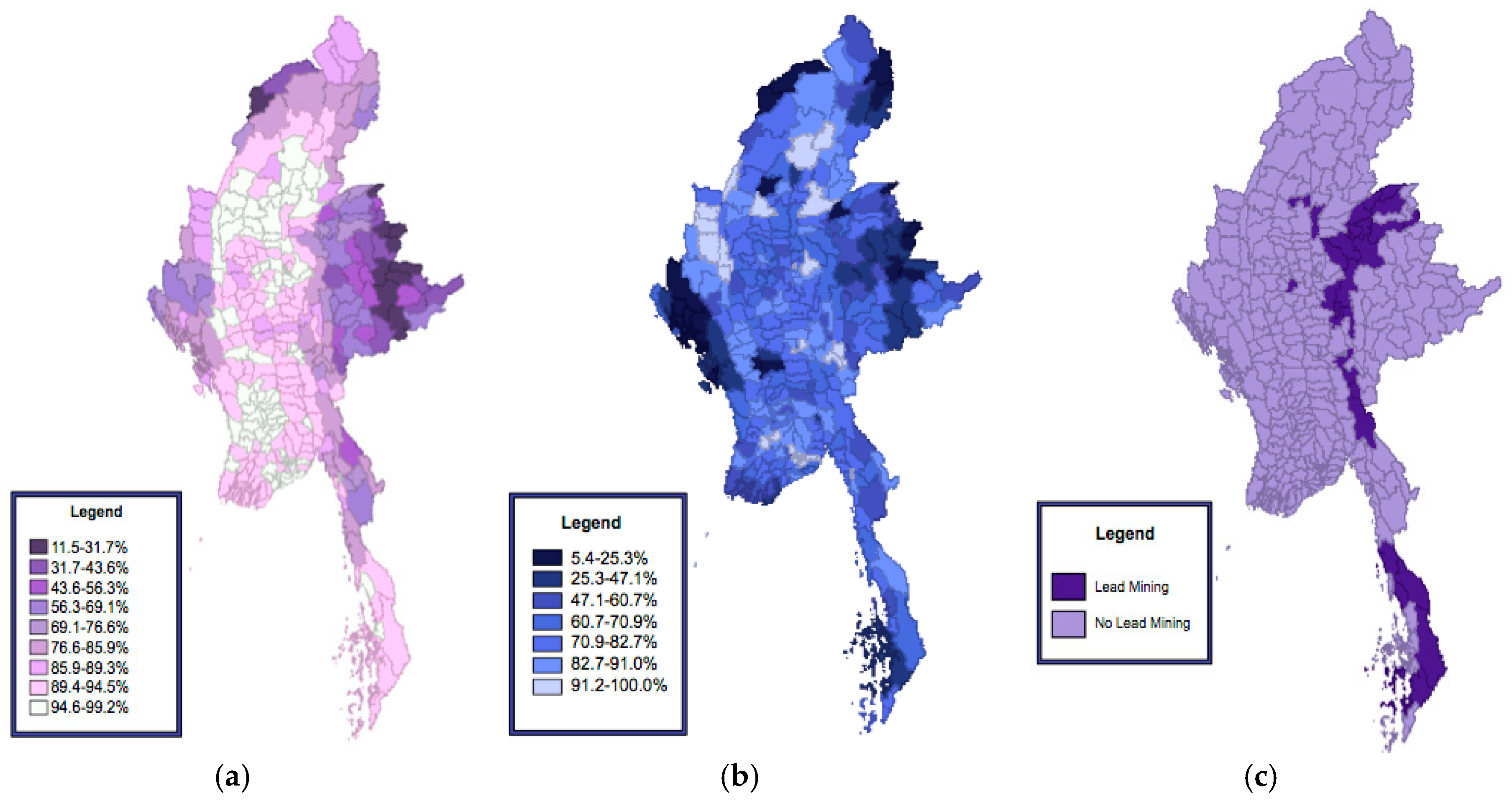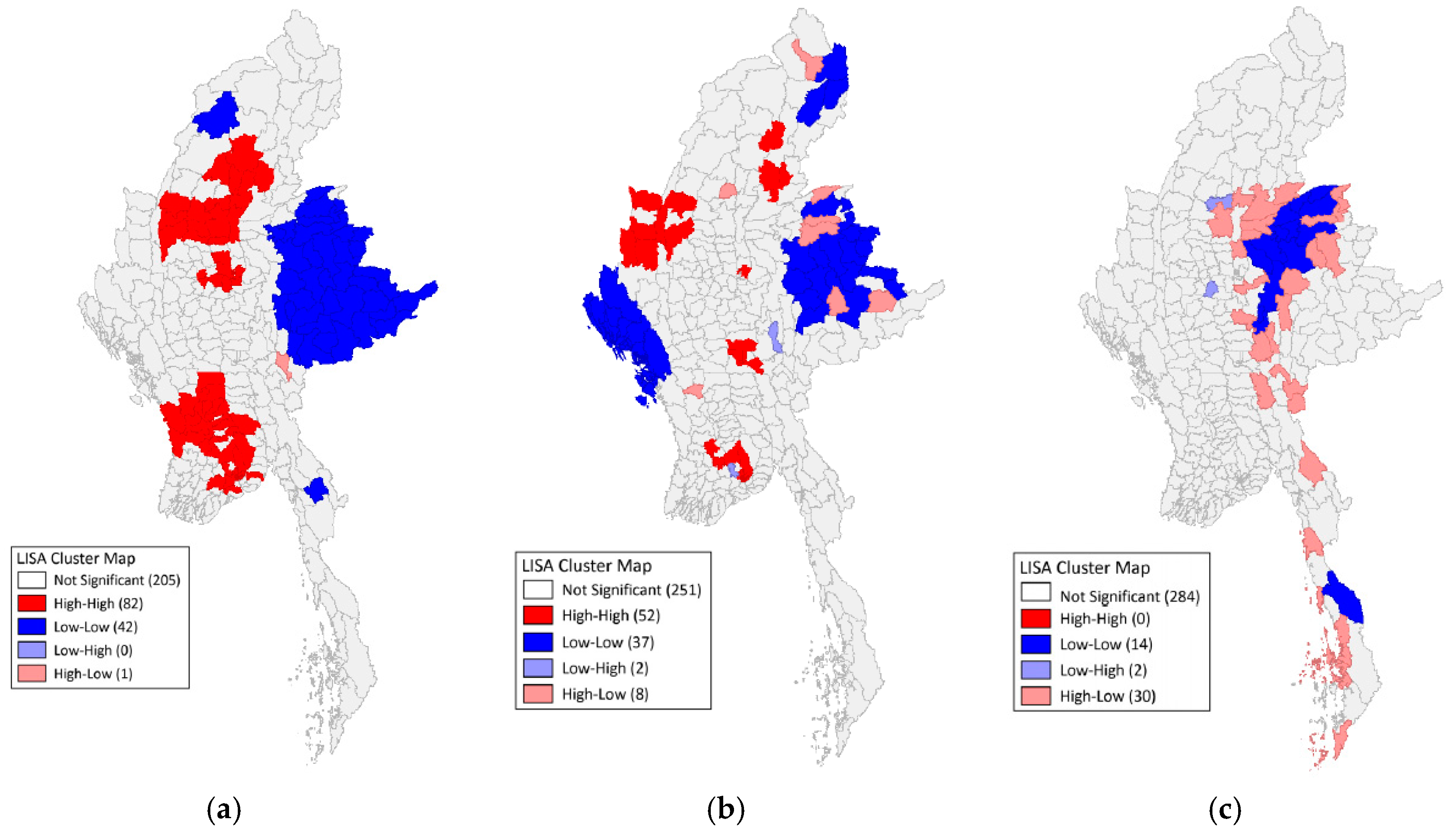Environmental Lead Exposure and Adult Literacy in Myanmar: An Exploratory Study of Potential Associations at the Township Level
Abstract
:1. Introduction
2. Materials and Methods
- (1)
- To screen and categorize the 330 townships in Myanmar as either lead mining or non-lead mining;
- (2)
- to use the 2014 Myanmar Census data to describe and map the adult literacy level and level of access to safe sanitation (as a measure of poverty/affluence) at the township level;
- (3)
- to stratify the townships by low and high levels of access to improved sanitation and to examine the relationship between lead exposure and Myanmar’s adult literacy in these two strata;
- (4)
- to explore global and local tests of spatial autocorrelation to identify patterns of clustering; and to map and report the results to inform future studies.
2.1. Data Collection
2.2. Study Population
2.3. Study Design
3. Results
3.1. Demographic Description
3.2. Adult Literacy
3.3. Access to Safe Sanitation
3.4. Lead Mining
3.5. Cluster Location Comparisons
3.6. Lead Mining and Adult Literacy
4. Discussion
5. Conclusions
Author Contributions
Acknowledgments
Conflicts of Interest
References
- White, S.; McCloskey, M. Framework for the 2003 National Assessment of Adult Literacy. U.S. Department of Education; National Center for Education Statistics: Washington, DC, USA, 2003.
- OECD/Statistics Canada. Learning a Living: First Results of the Adult Literacy and Life Skills Survey; OECD Publishing: Paris, France, 2005. [Google Scholar]
- Carlisle, J.C.; Dowling, K.C.; Siegel, D.M.; Alexeff, G.V. A blood lead benchmark for assessing risks from childhood lead exposure. J. Environ. Sci. Health A 2009, 44, 1200–1208. [Google Scholar] [CrossRef] [PubMed]
- Von Stumm, S.; Plomin, R. Socioeconomic status and the growth of intelligence from infancy through adolescence. Intelligence 2015, 48, 30–36. [Google Scholar] [CrossRef] [PubMed]
- Lind, A.; Johnston, A. Adult Literacy in the Third World: A Review of Objectives and Strategies; Swedish International Development Authority: Stockholm, Sweden, 1990; pp. 1–144.
- Katzung, B.G.; Masters, S.B.; Trevor, A.J. Heavy metal intoxication & chelators. In Basic & Clinical Pharmacology, 12th ed.; McGraw-Hill: New York, NY, USA, 2012; Volume 12, pp. 1013–1017. [Google Scholar]
- Rabinowitz, M.B. Toxicokinetics of bone lead. Environ. Health Perspect. 1991, 91, 33–37. [Google Scholar] [CrossRef] [PubMed]
- Karri, V.; Schuhmacher, M.; Kumar, V. Heavy metals (Pb, Cd, As and MeHg) as risk factors for cognitive dysfunction: A general review of metal mixture mechanism in brain. Environ. Toxicol. Pharmacol. 2016, 48, 203–213. [Google Scholar] [CrossRef] [PubMed]
- Grigoryan, R.; Petrosyan, V.; Melkom Melkomian, D.; Khachadourian, V.; McCartor, A.; Crape, B. Risk factors for children’s blood lead levels in metal mining and smelting communities in Armenia: A cross-sectional study. BMC Public Health 2016, 16, 945. [Google Scholar] [CrossRef] [PubMed]
- Reynolds, N. Myanmar’s Mining Industry; CSA Global: Perth, Australia, 2015. [Google Scholar]
- Gardiner, N.J.; Robb, L.J.; Searle, M.P. The metallogenic provinces of Myanmar. Appl. Earth Sci. 2014, 123, 25–38. [Google Scholar] [CrossRef]
- Mitchell, T.; Jentes, E.; Ortega, L.; Sucosky, M.S.; Jefferies, T.; Bajcevic, P.; Parr, V.; Jones, W.; Brown, M.J.; Painter, J. Lead poisoning in United States-bound refugee children: Thailand-Burma border, 2009. Pediatrics 2012, 129, e392–e399. [Google Scholar] [CrossRef] [PubMed]
- Pusapukdepob, J.; Sawangwong, P.; Pulket, C.; Satraphat, D.; Saowakontha, S.; Panutrakul, S. Health risk assessment of villagers who live near a lead mining area: A case study of Klity Village, Kanchanaburi Province, Thailand. Southeast Asian J. Trop. Med. Public Health 2007, 38, 168–177. [Google Scholar] [PubMed]
- Myanmar Information Management Unit (MIMU). Population in General. Available online: http://www.themimu.info/Census_2014_SR_dashboard%20 (accessed on 21 January 2018).
- Myanmar Information Management Unit (MIMU). Kayah State Socio-Economic Analysis. Available online: http://www.themimu.info/sites/themimu.info/files/documents/Asses-sment_Ka-yah_State_Socio-Economic_Analysis_-_Annexes_EU_Oct2013.pdf (accessed on 21 January 2018).
- Kwak, J.; Kim, K.; Park, M.; Kim, J.; Park, K. Determination of lead in soil at a historical mining and smelting site under laser-induced breakdown spectroscopy. Environ. Technol. 2012, 33, 2177–2184. [Google Scholar] [CrossRef] [PubMed]
- Anselin, L. Spatial Econometrics: Methods and Models; Kluwer Academic Publishers: Dordrecht, The Netherlands, 2008. [Google Scholar]
- Moran, P. The interpretation of statistical maps. J. R. Stat. Soc. 1948, 10, 243–251. [Google Scholar]
- Getis, A. A history of the concept of spatial autocorrelation: A geographer’s perspective. Geogr. Anal. 2008, 40, 297–309. [Google Scholar] [CrossRef]
- Anselin, L. Local Indicators of Spatial Association—LISA. Geogr. Anal. 1995, 27, 93–115. [Google Scholar] [CrossRef]
- Getis, A.; Aldstadt, J. Perspectives on Spatial Data Analysis; Anselin, L., Ray, S., Eds.; Springer: Berlin, Germany, 2010; Volume 36, pp. 147–163. [Google Scholar]
- Myanmar Information Management Unit. National Strategy for Rural Water Supply, Sanitation and Hygiene (WASH). Available online: http://www.themimu.info/sites/themimu.info/files/docume-nts/National_Strategy_for_Rural_Water_Supply_Sanitation_Hygiene_WASH_2016-2030_ENG.pdf (accessed on 21 January 2018).
- UNESCO. The Government of the Republic of the Union of Myanmar Ministry of Education: National Education for All (EFA) Review Report. Available online: http://unesdoc.unesco.org/images/0022/-002297/229723E.pdf (accessed on 21 January 2018).
- Kirsch, I.S. Adult Literacy in America: A First Look at the Results of the National Adult Literacy Survey; National Center for Education Statistics (ED): Washington, DC, USA, 1993.
- Kutner, M.; Greenberg, E.; Jin, Y.; Boyle, B.; Hsu, Y.; Dunleavy, E. Literacy in Everyday Life: Results from the 2003 National Assessment of Adult Literacy; National Center for Education Statistics (ED): Washington, DC, USA, 2003.
- Agneta, L.; Anton, J. Adult Literacy in the Third World: A Review of Objectives and Strategies. Swedish International Development Authority (SIDA), 1990. Available online: https://eric.ed.gov/?id=ED339819 (accessed on 21 January 2018).
- Pekar, Z.; Riley, N. Lead Human Exposure and Health Risk Assessments and Ecological Risk Assessment for Selected Areas: External Review Draft Technical Report; The International Classification of Functioning, Disability and Health: Research Triangle Park, NC, USA, 2006; pp. 1–221. [Google Scholar]
- Maddaloni, M.; Bellew, M.; Diamond, G.; Follansbee, M.; Gefell, D.; Goodrum, P.; Johnson, M.; Koporec, K.; Khoury, G.; Luey, J.; et al. Assessing lead risks at non-residential hazardous waste sites. Hum. Ecol. Risk Assess. 2005, 11, 967–1005. [Google Scholar] [CrossRef]
- Lanphear, B.P.; Roghmann, K.J. Pathways of lead exposure in urban children. Environ. Res. 1997, 74, 67–73. [Google Scholar] [CrossRef] [PubMed]
- Harvey, P.G.; Spurgeon, A.; Morgan, G.; Chance, J.; Moss, E. A method for assessing hand-to-mouth activity in children as a possible transport route for toxic substances. In Proceedings of the 5th International Conference on Heavy Metals in the Environment, Athens, Greece, 10–13 September 1985; Volume 1, pp. 436–438. [Google Scholar]
- Malcoe, L.H.; Lynch, R.A.; Keger, M.C.; Skaggs, V.J. Lead sources, behaviours, and socioeconomic factors in relation to blood lead of native American and white children: A community-based assessment of a former mining area. Environ. Health Perspect. 2002, 110, 221–231. [Google Scholar] [CrossRef] [PubMed]
- Papanikolaou, N.C.; Hatzidaki, E.G.; Belivanis, S.; Tzanakakis, G.N.; Tsatsakis, A.M. Lead toxicity update: A brief review. Med. Sci. Monit. 2005, 11, 329–336. [Google Scholar]
- Jarup, L. Hazards of heavy metal contamination. Br. Med. Bull. 2003, 68, 167–182. [Google Scholar] [CrossRef] [PubMed]
- Chisolm, J.J. The road to primary prevention of lead toxicity in children. Pediatrics 2001, 107, 581–583. [Google Scholar] [CrossRef] [PubMed]
- Chen, A.; Cai, B.; Dietrich, K.N.; Radcliffe, J.; Rogan, W.J. Lead exposure, IQ, and behavior in urban 5- to 7-year olds: Does lead affect behavior only by lowering IQ? Pediatrics 2007, 119, e650–e658. [Google Scholar] [CrossRef] [PubMed]
- McMichael, A.J.; Baghurst, P.A.; Vimpani, G.V.; Wigg, N.R.; Robertson, E.F.; Tong, S. Tooth lead levels and IQ in school-age children: The Port Pine cohort study. Am. J. Epidemiol. 1994, 140, 489–499. [Google Scholar] [CrossRef] [PubMed]
- Alloway, T.P.; Gregory, D. The predictive ability of IQ and working memory scores in literacy in an adult population. Int. J. Educ. Res. 2013, 57, 51–56. [Google Scholar] [CrossRef]
- Stewart, W.F.; Schwartz, B.S.; Davatzikos, C.; Shen, D.; Liu, D.; Wu, X.; Todd, A.C.; Shi, W.; Bassett, S.; Youssem, D. Past adult lead exposure is linked to neurodegeneration measured by brain MRI. Neurology 2006, 66, 1476–1484. [Google Scholar] [CrossRef] [PubMed]
- Wright, R.O.; Tsaih, S.W.; Schwartz, J. Lead exposure biomarkers and mini-mental status exam scores in older men. Epidemiology 2003, 14, 713–718. [Google Scholar] [CrossRef] [PubMed]
- Weisskopf, M.G.; Weuve, J.; Nie, H.; Saint-Hilaire, M.H.; Sudarsky, L.; Simon, D.K.; Hersh, B.; Schwartz, J.; Wright, R.O.; Hu, H. Association of cumulative lead exposure with Parksinson’s Disease. Environ. Health Perspect. 2010, 118, 1609. [Google Scholar] [CrossRef] [PubMed]
- Kamel, F.; Umbach, D.M.; Hu, H.; Munsat, T.L.; Shefner, J.M.; Taylor, J.A.; Sandler, D.P. Lead exposure as a risk factor for amyotrophic lateral sclerosis. Neurodegener. Dis. 2005, 2, 195–201. [Google Scholar] [CrossRef] [PubMed]
- Bakulski, K.M.; Rozek, L.S.; Dolinoy, D.C.; Paulson, H.L.; Hu, H. Alzheimer’s Disease and environmental exposure to lead: The epidemiologic evidence and potential role of epigenetics. Curr. Alzheimer Res. 2012, 9, 563–573. [Google Scholar] [CrossRef] [PubMed]
- Tong, S.; Schirnding, Y.E.; Prapamontol, T. Environmental lead exposure: A public health problem of global dimensions. Bull. World Health Organ. 2000, 78, 1068–1077. [Google Scholar] [PubMed]


| Descriptor | Townships in Myanmar n (%) |
|---|---|
| Lead Mine Development | |
| Lead mining activity | 29 (8.79%) |
| No lead mining activity | 301 (91.21%) |
| Adult Literacy | |
| High adult literacy level (>95% of township population) 1 | 105 (31.82%) |
| Low adult literacy level (<95% of township population) | 225 (68.18%) |
| Access to Safe Sanitation | |
| Access for >90% of township population 2 | 63 (19.09%) |
| Access for 70–90% of township population | 148 (44.85%) |
| Access for <70% of township population | 120 (36.6%) |
| Average and Range of Descriptors at the Township Level | Percentage (%) |
| Average adult literacy rate | 85.56% |
| Range of adult literacy rates | 11.5–99.2% |
| Average level of access to safe sanitation | 71.42% |
| Range of access to safe sanitation | 5.4–100.0% |
| Descriptor | Low Adult Literacy Level (≤89.1% of Population) | High Adult Literacy Level (>89.1% of Population) | p-Value |
|---|---|---|---|
| Lead Mining Development | |||
| Lead Mining | 19 (5.76%) | 10 (3.03%) | <0.01 * |
| No Lead Mining | 92 (27.88%) | 209 (63.33%) | |
| Access to Safe Sanitation | |||
| High Proportion (>83.3% of Population) | 18 (5.45%) | 93 (28.18%) | <0.01 * |
| Low Proportion (<83.3% of Population) | 93 (28.18%) | 126 (38.18%) | |
| Townships with High Access to Safe Sanitation (>83.3%) | |||
| Lead Mining | 3 (0.91%) | 1 (0.30%) | 0.01 ** |
| No Lead Mining | 15 (4.55%) | 92 (27.88%) | |
| Townships with Low Access to Safe Sanitation (<83.3%) | |||
| Lead Mining | 16 (4.85%) | 9 (2.73%) | <0.05 * |
| No Lead Mining | 77 (23.33%) | 117 (35.45%) | |
© 2018 by the authors. Licensee MDPI, Basel, Switzerland. This article is an open access article distributed under the terms and conditions of the Creative Commons Attribution (CC BY) license (http://creativecommons.org/licenses/by/4.0/).
Share and Cite
MacTavish, R.C.; Rémillard, L.W.; Davison, C.M. Environmental Lead Exposure and Adult Literacy in Myanmar: An Exploratory Study of Potential Associations at the Township Level. Int. J. Environ. Res. Public Health 2018, 15, 1086. https://doi.org/10.3390/ijerph15061086
MacTavish RC, Rémillard LW, Davison CM. Environmental Lead Exposure and Adult Literacy in Myanmar: An Exploratory Study of Potential Associations at the Township Level. International Journal of Environmental Research and Public Health. 2018; 15(6):1086. https://doi.org/10.3390/ijerph15061086
Chicago/Turabian StyleMacTavish, Robert C., Liam W. Rémillard, and Colleen M. Davison. 2018. "Environmental Lead Exposure and Adult Literacy in Myanmar: An Exploratory Study of Potential Associations at the Township Level" International Journal of Environmental Research and Public Health 15, no. 6: 1086. https://doi.org/10.3390/ijerph15061086
APA StyleMacTavish, R. C., Rémillard, L. W., & Davison, C. M. (2018). Environmental Lead Exposure and Adult Literacy in Myanmar: An Exploratory Study of Potential Associations at the Township Level. International Journal of Environmental Research and Public Health, 15(6), 1086. https://doi.org/10.3390/ijerph15061086





